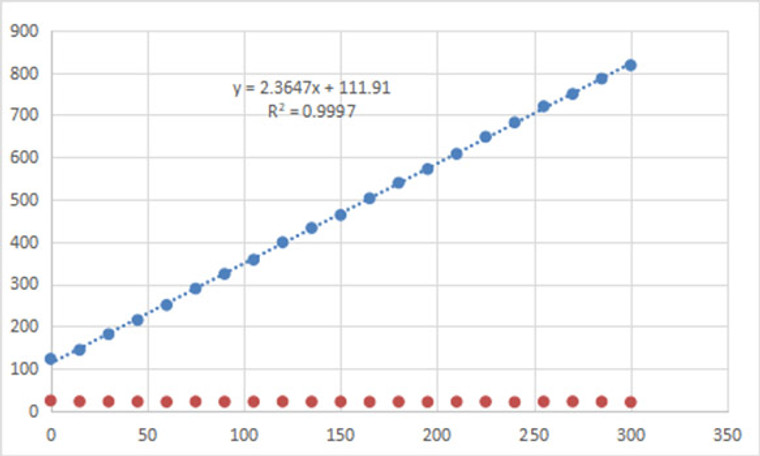| Host: |
HEK293 cells |
| Reactivity: |
Human |
| Note: |
STRICTLY FOR FURTHER SCIENTIFIC RESEARCH USE ONLY (RUO). MUST NOT TO BE USED IN DIAGNOSTIC OR THERAPEUTIC APPLICATIONS. |
| Short Description: |
Active Recombinant-Human Prolyl endopeptidase FAP-C-His protein was developed from hek293 cells and has a target region of C-His. For use in research applications. |
| Formulation: |
Supplied as a 0.22 Mu m filtered solution in PBS, pH 7.4. |
| Immunoreactivity: |
Measured by its binding ability in a functional ELISA. Immobilized Human FAP at 1 Mu g/mL (100 Mu L/well) can bind FAP Rabbit mAb with a linear range of 0.03-3.94 ng/mL.2. Measured by its ability to convert the substrate benzyloxycarbonyl-Gly-Pro-7-a |
| Gene Symbol: |
FAP |
| Gene ID: |
2191 |
| Uniprot ID: |
SEPR_HUMAN |
| Immunogen Region: |
Leu26-Asp760 |
| Immunogen: |
Recombinant Human Prolyl endopeptidase FAP Protein is produced by HEK293 cells expression system. The target protein is expressed with sequence (Leu26-Asp760) of human FAP/FAPalpha (Accession #NP_004451.2) fused with a 6×His tag at the C-terminus. |
| Tissue Specificity | Expressed in adipose tissue. Expressed in the dermal fibroblasts in the fetal skin. Expressed in the granulation tissue of healing wounds and on reactive stromal fibroblast in epithelial cancers. Expressed in activated fibroblast-like synoviocytes from inflamed synovial tissues. Expressed in activated hepatic stellate cells (HSC) and myofibroblasts from cirrhotic liver, but not detected in normal liver. Expressed in glioma cells (at protein level). Expressed in glioblastomas and glioma cells. Isoform 1 and isoform 2 are expressed in melanoma, carcinoma and fibroblast cell lines. |
| Post Translational Modifications | N-glycosylated. The N-terminus may be blocked. |
| Function | Cell surface glycoprotein serine protease that participates in extracellular matrix degradation and involved in many cellular processes including tissue remodeling, fibrosis, wound healing, inflammation and tumor growth. Both plasma membrane and soluble forms exhibit post-proline cleaving endopeptidase activity, with a marked preference for Ala/Ser-Gly-Pro-Ser/Asn/Ala consensus sequences, on substrate such as alpha-2-antiplasmin SERPINF2 and SPRY2. Degrade also gelatin, heat-denatured type I collagen, but not native collagen type I and IV, vitronectin, tenascin, laminin, fibronectin, fibrin or casein. Also has dipeptidyl peptidase activity, exhibiting the ability to hydrolyze the prolyl bond two residues from the N-terminus of synthetic dipeptide substrates provided that the penultimate residue is proline, with a preference for Ala-Pro, Ile-Pro, Gly-Pro, Arg-Pro and Pro-Pro. Natural neuropeptide hormones for dipeptidyl peptidase are the neuropeptide Y (NPY), peptide YY (PYY), substance P (TAC1) and brain natriuretic peptide 32 (NPPB). The plasma membrane form, in association with either DPP4, PLAUR or integrins, is involved in the pericellular proteolysis of the extracellular matrix (ECM), and hence promotes cell adhesion, migration and invasion through the ECM. Plays a role in tissue remodeling during development and wound healing. Participates in the cell invasiveness towards the ECM in malignant melanoma cancers. Enhances tumor growth progression by increasing angiogenesis, collagen fiber degradation and apoptosis and by reducing antitumor response of the immune system. Promotes glioma cell invasion through the brain parenchyma by degrading the proteoglycan brevican. Acts as a tumor suppressor in melanocytic cells through regulation of cell proliferation and survival in a serine protease activity-independent manner. |
| Protein Name | Prolyl Endopeptidase Fap170 Kda Melanoma Membrane-Bound GelatinaseDipeptidyl Peptidase FapFibroblast Activation Protein AlphaFapalphaGelatine Degradation Protease FapIntegral Membrane Serine ProteasePost-Proline Cleaving EnzymeSerine Integral Membrane ProteaseSimpSurface-Expressed ProteaseSeprase Cleaved Into - Antiplasmin-Cleaving Enzyme Fap - Soluble FormApce |
| Cellular Localisation | Prolyl Endopeptidase Fap: Cell SurfaceCell MembraneSingle-Pass Type Ii Membrane ProteinCell ProjectionLamellipodium MembraneInvadopodium MembraneRuffle MembraneMembraneLocalized On Cell Surface With Lamellipodia And Invadopodia Membranes And On Shed VesiclesColocalized With Dpp4 At Invadopodia And Lamellipodia Membranes Of Migratory Activated Endothelial Cells In Collagenous MatrixColocalized With Dpp4 On Endothelial Cells Of Capillary-Like Microvessels But Not Large Vessels Within Invasive Breast Ductal CarcinomaAnchored And Enriched Preferentially By Integrin Alpha-3/Beta-1 At InvadopodiaPlasma Membrane Protrusions That Correspond To Sites Of Cell InvasionIn A Collagen-Dependent MannerLocalized At Plasma And Ruffle Membranes In A Collagen-Independent MannerColocalized With Plaur Preferentially At The Cell Surface Of Invadopodia Membranes In A Cytoskeleton-Integrin- And Vitronectin-Dependent MannerConcentrated At Invadopodia MembranesSpecialized Protrusions Of The Ventral Plasma Membrane In A Fibrobectin-Dependent MannerColocalizes With Extracellular Components (Ecm)Such As Collagen Fibers And FibronectinAntiplasmin-Cleaving Enzyme FapSoluble Form: SecretedFound In Blood Plasma And SerumIsoform 2: Cytoplasm |
| Alternative Protein Names | Prolyl Endopeptidase Fap protein170 Kda Melanoma Membrane-Bound Gelatinase proteinDipeptidyl Peptidase Fap proteinFibroblast Activation Protein Alpha proteinFapalpha proteinGelatine Degradation Protease Fap proteinIntegral Membrane Serine Protease proteinPost-Proline Cleaving Enzyme proteinSerine Integral Membrane Protease proteinSimp proteinSurface-Expressed Protease proteinSeprase Cleaved Into - Antiplasmin-Cleaving Enzyme Fap - Soluble Form proteinApce proteinFAP protein |
Information sourced from Uniprot.org
12 months for antibodies. 6 months for ELISA Kits. Please see website T&Cs for further guidance











